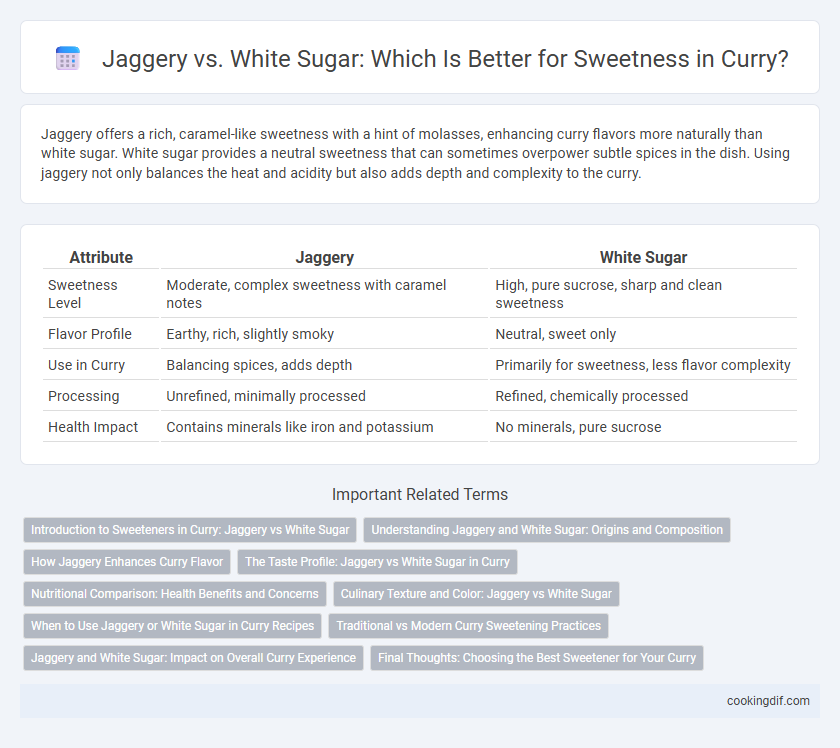Jaggery offers a rich, caramel-like sweetness with a hint of molasses, enhancing curry flavors more naturally than white sugar. White sugar provides a neutral sweetness that can sometimes overpower subtle spices in the dish. Using jaggery not only balances the heat and acidity but also adds depth and complexity to the curry.
Table of Comparison
| Attribute | Jaggery | White Sugar |
|---|---|---|
| Sweetness Level | Moderate, complex sweetness with caramel notes | High, pure sucrose, sharp and clean sweetness |
| Flavor Profile | Earthy, rich, slightly smoky | Neutral, sweet only |
| Use in Curry | Balancing spices, adds depth | Primarily for sweetness, less flavor complexity |
| Processing | Unrefined, minimally processed | Refined, chemically processed |
| Health Impact | Contains minerals like iron and potassium | No minerals, pure sucrose |
Introduction to Sweeteners in Curry: Jaggery vs White Sugar
Jaggery and white sugar are common sweeteners used in curry, each contributing distinct flavors and nutritional profiles. Jaggery, a traditional unrefined sweetener made from sugarcane juice or palm sap, imparts a rich, caramel-like taste with trace minerals like iron and magnesium. White sugar, chemically refined sucrose, offers intense sweetness without additional nutrients but dissolves quickly, making it ideal for consistent sweetness in curry dishes.
Understanding Jaggery and White Sugar: Origins and Composition
Jaggery is an unrefined sugar product made from sugarcane juice or palm sap, retaining molasses and minerals such as iron, calcium, and potassium, which contribute to its deeper flavor and darker color. White sugar, primarily derived from refined sugarcane or sugar beets, undergoes extensive processing to remove molasses and impurities, resulting in pure sucrose crystals with no additional nutrients. In culinary applications like curry, jaggery offers a richer, caramel-like sweetness and complex taste profile, while white sugar provides a cleaner but less nuanced sweetness.
How Jaggery Enhances Curry Flavor
Jaggery adds a rich, caramel-like sweetness to curry that white sugar cannot replicate, enhancing the depth and complexity of the dish. Its natural molasses content infuses the curry with subtle earthy and smoky notes, balancing spicy and tangy flavors more effectively than refined sugar. Using jaggery in curry promotes authentic taste profiles and adds nutritional benefits such as trace minerals absent in white sugar.
The Taste Profile: Jaggery vs White Sugar in Curry
Jaggery imparts a rich, caramel-like sweetness with subtle notes of molasses, enhancing the depth and complexity of curry flavors, while white sugar provides a clean, straightforward sweetness that brightens the dish without altering its base taste. The earthy undertones of jaggery complement spices like cumin and coriander, creating a balanced and robust flavor profile. White sugar's neutrality allows other spices to shine more distinctly but may result in a less layered taste experience.
Nutritional Comparison: Health Benefits and Concerns
Jaggery contains essential minerals like iron, magnesium, and potassium, offering more nutritional value than refined white sugar, which is primarily empty calories. It has a lower glycemic index, causing a slower rise in blood sugar levels, making it a better option for managing energy and cravings. However, jaggery is still high in calories and should be consumed in moderation to avoid risks like weight gain and blood sugar spikes.
Culinary Texture and Color: Jaggery vs White Sugar
Jaggery imparts a rich, caramel-like texture and deep golden to brown color to curry, enhancing both its visual appeal and mouthfeel with a slightly coarse consistency. White sugar, in contrast, dissolves completely and offers a neutral sweetness with no impact on the curry's color or texture, making it ideal for clear or lightly colored dishes. The choice between jaggery and white sugar significantly influences the curry's overall sensory experience, balancing sweetness with complexity and depth.
When to Use Jaggery or White Sugar in Curry Recipes
Jaggery provides a rich, caramel-like sweetness that enhances the depth of flavors in traditional Indian curries such as sambar and rasam, making it ideal for slow-cooked dishes that benefit from its complex taste profile. White sugar offers a clean, straightforward sweetness suitable for quick-cooking curries like tomato-based or coconut milk curries, where a subtle balance is needed without overpowering the spices. Use jaggery to add a natural sweetness and earthy aroma when the recipe calls for a robust flavor contrast, while white sugar is preferred for lighter, mildly sweet curry preparations.
Traditional vs Modern Curry Sweetening Practices
Traditional curry recipes often incorporate jaggery, a natural unrefined sugar made from sugarcane or palm sap, which imparts a deep, caramel-like sweetness and rich mineral content enhancing complex flavor profiles. Modern curry sweetening practices tend to favor white sugar due to its consistent sweetness and ease of use, though this results in a cleaner, less nuanced taste. The choice between jaggery and white sugar significantly influences the authenticity and depth of curry dishes, with jaggery preserving traditional culinary heritage and white sugar aligning with contemporary convenience.
Jaggery and White Sugar: Impact on Overall Curry Experience
Jaggery enhances the overall curry experience by adding a rich, caramel-like sweetness and depth of flavor that complements savory spices, unlike white sugar which provides a simple, pure sweetness. The mineral content in jaggery, including iron and potassium, contributes subtle earthy notes, elevating the complexity and aroma of the dish. Using jaggery instead of white sugar can transform the curry's taste profile, creating a more balanced and authentic flavor that is essential in traditional Indian cuisine.
Final Thoughts: Choosing the Best Sweetener for Your Curry
Jaggery offers a richer, caramel-like sweetness with added mineral benefits, enhancing the depth of flavor in curries compared to white sugar's clean, straightforward sweetness. Its unrefined nature retains nutrients such as iron and calcium, making curries not only tastier but slightly healthier. Opt for jaggery in traditional or spicy curry recipes to achieve a more complex sweetness, while white sugar suits lighter or quicker dishes that require a subtle, neutral sweetener.
Jaggery vs white sugar for sweetness Infographic

 cookingdif.com
cookingdif.com